Descriptive Statements:
- Demonstrate knowledge of the purposes and functions of art in Africa, the Near East, and the Middle East from ancient times to the present.
- Demonstrate knowledge of the purposes and functions of art in Asia and Oceania from ancient times to the present.
- Demonstrate knowledge of the purposes and functions of art in Central and South America from ancient times to the present.
- Demonstrate knowledge of the purposes and functions of art in Europe from ancient times to the present.
- Demonstrate knowledge of the purposes and functions of art in North America from ancient times to the present.
Sample Item:
In traditional Tibetan Buddhist sandpainting, monks work in groups for many days pouring
brightly colored powders on a flat surface to create complex, symbolic compositions known
as mandalas. After a short time, the work is destroyed, representing the impermanence of
life. This is an example of the function of art as a:
- form of entertainment.
- means of social commentary.
- spiritual practice.
- documentation of history.
Correct Response and Explanation (Show Correct ResponseHide Correct Response)
C. This question requires the examinee to demonstrate knowledge of the
function of the practice of Tibetan Buddhist sandpainting. The ritual of
constructing and destroying sandpaintings is considered a spiritual practice and a step
in the Tibetan Buddhist path to enlightenment.
Descriptive Statements:
- Demonstrate knowledge of how works of art and architecture from Africa, the Near East, and the Middle East from ancient times to the present relate to their historical context.
- Demonstrate knowledge of how works of art and architecture from Asia and Oceania from ancient times to the present relate to their historical context.
- Demonstrate knowledge of how works of art and architecture from Central and South America from ancient times to the present relate to their historical context.
- Demonstrate knowledge of how works of art and architecture from Europe from ancient times to the present relate to their historical context.
- Demonstrate knowledge of how works of art and architecture from North America from ancient times to the present relate to their historical context.
Sample Item:
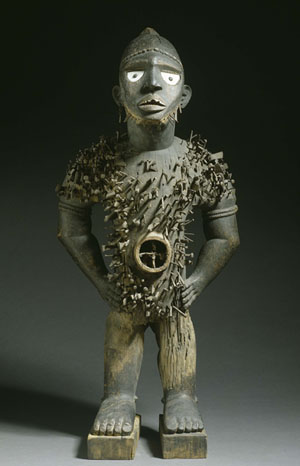
He is stylistically carved in a simple frontal standing posture with his hands on his hips. Decorative bands encircle his brow and upper arms. Nails have been driven into the visible portion of his torso and shoulders. In the center of his torso, approximately where a navel might appear, is a round cavity of about the same diameter as his arm.
Source: Unknown artist. Nkondi tatu oath taking figure. Bildarchiv Preussischer Kulturbesitz/Art Resource, NY. Used with permission.
In the Kongo culture, nkisi nkonde sculptures, such as the one shown above, are
believed to become endowed with specific powers through the placement of particular
substances into the container near the figure's abdominal region. Individuals can then
activate these powers in times of need by driving a nail or other object into the figure.
This use of art indicates that the Kongo culture values art as a way to:
- unite the community.
- exert control over life events.
- memorialize ancestors.
- express personal emotions.
Correct Response and Explanation (Show Correct ResponseHide Correct Response)
B. This question requires the examinee to demonstrate knowledge of how
an artwork from Kongo relates to its cultural and historical context.
Individuals interact with the nkisi nkonde sculptures to summon spirits to
help them with a wide range of concerns, such as curing illness and stimulating crop
growth. In this way, the Kongo people value art as a way to exert control over their
lives.
Descriptive Statements:
- Demonstrate knowledge of how art from Africa, the Near East, and the Middle East from ancient times to the present influenced and was influenced by art from other groups and historical periods.
- Demonstrate knowledge of how art from Asia and Oceania from ancient times to the present influenced and was influenced by art from other groups and historical periods.
- Demonstrate knowledge of how art from Central and South America from ancient times to the present influenced and was influenced by art from other groups and historical periods.
- Demonstrate knowledge of how art from Europe from ancient times to the present influenced and was influenced by art from other groups and historical periods.
- Demonstrate knowledge of how art from North America from ancient times to the present influenced and was influenced by art from other groups and historical periods.
Sample Item:
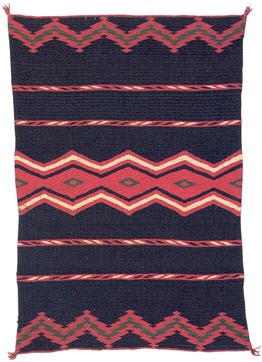
Source: Unknown artist. Image of Navajo blanket, Banded background, 1870– to 1875. Length 75" inches, Natural History Museum of Los Angeles County, William Randolph Hearst Collection, Anthropology Department, Natural History Museum of Los Angeles County. Used with permission.
The geometric patterns used on the woven Navajo blanket shown above reflect an influence
from the artistic traditions common in:
- Alaska.
- Mexico.
- Hawaii.
- Canada.
Correct Response and Explanation (Show Correct ResponseHide Correct Response)
B. This question requires the examinee to demonstrate knowledge of how
artwork from the Navajo culture was influenced by art from another group. In the 1860s,
the Navajo people were forcibly relocated to New Mexico by the U.S. government. It was
there that Navajo weavers were influenced by the designs of Mexican serapes, woven garments
that frequently featured geometric motifs.
Descriptive Statements:
- Demonstrate knowledge of the distinguishing characteristics of art from Africa, the Near East, and the Middle East from ancient times to the present.
- Demonstrate knowledge of distinguishing characteristics of art from Asia and Oceania from ancient times to the present.
- Demonstrate knowledge of distinguishing characteristics of art from Central and South America from ancient times to the present.
- Demonstrate knowledge of distinguishing characteristics of art from Europe from ancient times to the present.
- Demonstrate knowledge of distinguishing characteristics of art from North America from ancient times to the present.
Sample Item:
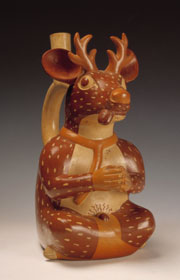
The figure has the coloring of a deer, with a reddish-brown coat speckled with light tan and a light tan belly and throat. The legs are crossed and the hands are clasped over the chest. The head has the features of a male deer with antlers, and something protrudes from the side of its mouth, possibly a tongue. A brownish-orange band encircles the neck, and one end hangs down in front of the chest. Bands of the same color encircle the lower legs. At the back of the figure is a curved shape like the handle of a pitcher or mug, topped by a cylindrical vertical spout.
Source: Museo Larco, Lima - Perú. ML010499
The stirrup spout and animal form of the work shown above are characteristic of the
early art of:
- Peru.
- eastern Europe.
- Polynesia.
- Iran.
Correct Response and Explanation (Show Correct ResponseHide Correct Response)
A. This question requires the examinee to demonstrate knowledge of a
distinguishing characteristic of art from South America. This ceramic jar's naturalistic
depiction of an animal and its stirrup spout are characteristic of the art of the Moche
people of Peru.
Descriptive Statements:
- Analyze the similarities and differences in how the elements and principles of art are used in artworks from various heritages and historical periods.
- Analyze the similarities and differences in how tools, media, techniques, and processes are used in artworks from various heritages and historical periods.
- Demonstrate knowledge of how similar themes or subjects have been treated by artists from various heritages or historical periods.
- Compare and contrast the use of visual symbols in artworks from various heritages and historical periods.
Sample Item:
|
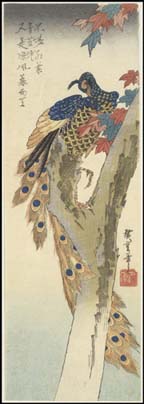
|
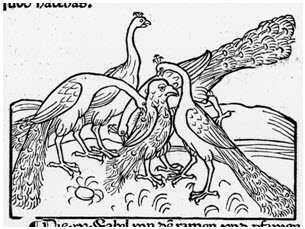
|
|
Image 1
Source: Image 1 Hiroshige, Utagawa. Peacock Perched on a Maple Tree in
Autumn, Kujaku ni Momiji. ca.circa 1833. Polychrome woodblock print; ink and
color on paper, 14 13/16 x 5 in. (37.6 x 12.7 cm)14 start fraction 13 over 16 end fraction by 5 inches (37.6 by 12.7 centimeters). The Metropolitan Museum of Art/Art
Resource, NY. Used with permission.
|
Image 2
Source: Image 2 Zainer, Johan. Jay and Peacocks (Aesop, Vita et
Fabulae). PML 23211. The Pierpont Morgan Library, Art Resources, NY. Used with permission.
|
While the two woodblock prints shown above were created using the same medium and share
similar content, which of the following is a significant difference between them?
- Image 1 is a realistic depiction of the subject, while Image 2 is abstract.
- Several blocks were required to print Image 1, while only one was required for Image 2.
- Image 1 is a portrait of the subject, while Image 2 is a portrait that presents the subject as a symbol.
- Line is used in Image 1 primarily to define edges, while line is used in Image 2 primarily to create asymmetrical balance.
Correct Response and Explanation (Show Correct ResponseHide Correct Response)
B. This question requires the examinee to analyze a significant
difference between two artworks. Woodblock printing is a type of relief printing
in which artists remove the surface areas of the block around the design. Incorporating
more than one color in a woodblock print generally requires one block per color.
Image 1 features several ink colors and therefore required several blocks for printing,
while Image 2 has one ink and required only one block for printing.
Descriptive Statements:
- Demonstrate knowledge of ways in which the works of contemporary artists reflect, play a role in, and influence the present-day.
- Demonstrate knowledge of ways in which visual images shape worldwide responses to societal developments or historical events.
- Demonstrate knowledge of ways in which visual images in popular media and advertising influence society.
- Demonstrate knowledge of ways in which social ideas, themes, and concepts (e.g., individual identity, community, power, authority, feminism, environmentalism) are reflected in works of art.
- Demonstrate knowledge of ways in which changes in society have influenced how viewers respond to given works of art.
Sample Item:
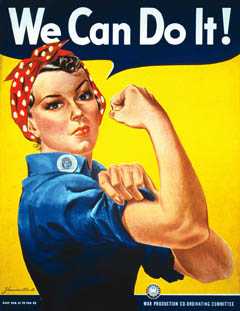
Her body faces to the right and her head is turned back toward the viewer. Her left arm is bent towards her right shoulder, and her left hand is holding the rolled-up cuff of her right sleeve. Her right arm is angled toward the viewer and bent upwards at the elbow, and her right hand is in a fist to the right of her face. Above the woman is a thought bubble with large print that says We Can Do It!
Source: We can do it! Courtesy National Archives, photo no. 535413. Creator: Office for Emergency Management. War Production Board. 1/1942-11/3/1945
In this work, the artist uses the combination of text and image for the purpose of:
- confronting assumptions.
- satirizing the genre of advertising.
- exploring class issues.
- promoting a healthy lifestyle.
Correct Response and Explanation (Show Correct ResponseHide Correct Response)
A. This question requires the examinee to demonstrate knowledge of ways
in which visual images in popular media influence society. When the United
States became involved in World War II2, manufacturing jobs were vacated by men who were
needed to fight in the war. In an effort to encourage women to fill those jobs,
corporations and the United States government created propaganda posters that equated
the importance of work with fighting in the war. The text and image used in this poster
portrays women as strong and capable of doing the work previously done by men, thus having
the effect of confronting the belief that women could not work outside the home.